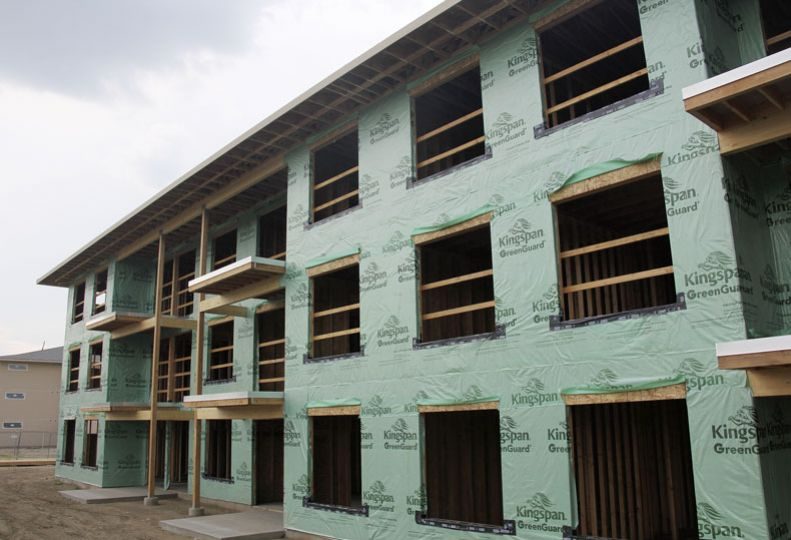
Home » Multifamily multiplying: Permit data shows surge in what was already a bustling apartment construction market
Multifamily multiplying: Permit data shows surge in what was already a bustling apartment construction market
Permit activity suggests apartment construction isn't slowing down just yet

June 22, 2023
Apartment construction isn’t letting up anytime soon, if building permit activity from the first five months of 2023 is any indication.
From January to the end of May this year, three municipalities issued 57 multifamily permits that will add 1,023 residential units to the housing supply once construction is complete, according to permit information provided by representatives of Spokane County and the cities of Spokane and Spokane Valley.
Another 11 permit applications are pending in Spokane County that could add 234 units to that total.
Multifamily permitting has had double-digit increases in the first five months of this year in all three jurisdictions, compared with year-earlier permit totals.
The city of Spokane has issued 25% more multifamily permits from January through the end of May this year than in the year-earlier period. In unincorporated Spokane County, multifamily permits grew 60% in the same time period, compared with the year-earlier period. In the city of Spokane Valley, permits for multifamily developments increased 144.4%, to 22 permits, in the first five months of this year, from nine permits issued in the year-earlier period.
Through May, the city of Spokane issued 30 multifamily permits that would add 524 residential units to the housing supply, permit information shows. The number of units this year has declined 7.3%, from 565 units in the first five months of 2022.
Steve MacDonald, community and economic development director for the city of Spokane, says that current permit activity is driven by low apartment vacancy rates.
“Whenever you have low vacancies and high rents, people want to take advantage of that by building more apartments,” MacDonald says. “You’re not going to see that when there’s huge vacancy rates or rents declining, which go hand-in-hand. So it’s just following what the demand for housing is here.”
Data from the Spokane County Apartment Vacancy Survey published this spring in the Real Estate Report by the Spokane-Kootenai Real Estate Research Committee shows that the county’s overall vacancy rate in Q1 is 5%, from the county’s overall vacancy rate in Q3 2022 of 3.8%.
MacDonald says the vacancy rate is still considered low, even though rates have been increasing slightly since September 2020.
He notes that multifamily permit totals now include additions and change-of-use permits, along with new construction permits. The inclusion provides a more accurate representation of multifamily permit activity, he says. For example, projects such as an office-to-apartment conversion now are included in multifamily permit reports.
Permit data shows that half of the top 10 highest-valued construction projects permitted this year are for apartment projects with a combined construction value of $68.1 million.
The top five multifamily developments in the city of Spokane in terms of permit value in the first five months of the year are:
•The $28.1 million, 180-unit Magnesium Village, at 849 E. Magnesium Road.
•The 162-unit, $25 million Iron Bridge apartments, at 222 N. Wall.
•The $7.8 million, 60-unit Millennium North Hill, at 3909 N. Wall.
•The $4.3 million, 26-unit Mission Court apartments, at 1449 N. Madelia.
•The $2.9 million, 24-unit Upriver apartments, at 3024 E. Jackson.
Compared to the first five months of 2020, permits issued in the city of Spokane through May of this year are 173% higher, and total units are a whopping 329.5% higher.
MacDonald says the pandemic contributed to lower multifamily permit activity in 2020, which halted many developments for part of the year.
Demand in 2023 has been affected by the Building Opportunity and Choices for All pilot program, which eased development standards for multifamily housing options within the city of Spokane beginning last year. MacDonald says the program has helped generate more interest in multifamily development in 2023, but it hasn’t yet made a significant impact on the number of units that have been permitted.
MacDonald says he expects to see a flurry of multifamily permit applications before new energy codes go into effect this fall that will add to construction and compliance costs.
“People are going to rush to get in prior to that deadline, even for projects that aren’t going to possibly even be built this year,” says MacDonald. “They’ll have two years to actually get that done.”
Multifamily permit activity in unincorporated Spokane County is strong, says county CEO Scott Simmons.
Five multifamily permits with a total of 144 residential units have been permitted by the county in the first five months of the year.
Simmons notes that since new construction permits aren’t always issued in the same year that project applications are received, the total of multifamily permits is higher counting the county’s 11 pending multifamily permits for 234 units. Including pending applications, 16 permits with 378 units are on file.
“We’d certainly like to try to get them all issued this year, but it depends on what phase they are in and if they’re asking for changes throughout (the permit-review process),” says Simmons.
In the first five months of last year, Spokane County received 10 multifamily permit applications. In 2021, the county received 16 applications in the first five months, he says.
Simmons attributes the varied application activity to tightening availability of land since 2021 in addition to limited financing, increased demand, and higher costs associated with construction labor and materials.
The top three highest-value multifamily projects permitted in Spokane County through the first five months of the year have a combined construction value of $14.1 million.
They are the Farwell Apartment complex, at 102 E. Farwell, in North Spokane; Garden Springs Apartments, at 4719 W. Garden Springs Road, in west Spokane; and Fairway Apartments, at 9907 W. Aero Road, in Medical Lake.
Emily Estes-Cross, public information officer for the city of Spokane Valley, says via email correspondence with the Journal that the municipality issued 22 multifamily permits from January to May this year, however most of those permits aren’t creating new residential units.
Twenty of the permits issued are for remodel and repair projects in existing multifamily buildings, she says.
The two multifamily projects permitted for new construction in Spokane Valley this year will create 355 residential units. The first is the $45.1 million, 300-unit Mirabeau Place apartments located on the former Elks Lodge property west of North Pines Road, at 2605 N. Robie Road. The second is the $6.9 million, 55-unit 4th Avenue apartments located a few blocks south of Sprague Avenue and east of South Pines Road, at 12717 E. Fourth.
Estes-Cross says pre-application and building permit requests for multifamily projects have remained consistent throughout the year. However, compared to pre-pandemic years, she says there are more conference requests that don’t result in new building applications.
Permits issued so far this year in the city of Spokane Valley are nearly equal in number to the 23 multifamily permits the municipality issued in the first five months of 2020.
The city of Spokane is well ahead of the number of permits issued this year, from those issued in 2020, by a margin of 172.3%.
Overall, the three jurisdictions report increasing multifamily permit activity from a year ago.
If multifamily permitting trends continue the same trajectory for the remainder of the year in the city of Spokane, then MacDonald says it’s likely the number of residential units will exceed the 1,100 total units that were permitted in 2022.
Simmons says that a growing number of residential units are expected to come online this year, but if permit activity for multifamily properties continues its current trajectory, Spokane County will still have a housing deficit.
He explains that high interest rates continue to impact multifamily development financing and softening rental prices could alter end-of-year multifamily permit totals.
He says the Spokane Association of Realtors has reported a housing deficit of about 32,000 residential units.
“If we’ve got 144 permits issued this year and we’ve got 234 that are pending, that’s certainly nowhere near our needs,” Simmons says. “I think we still have a long way to go to be able to really meet the needs in the community.”
Latest News Up Close Real Estate & Construction
Related Articles
Related Products





